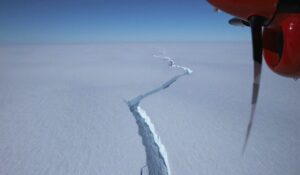A mega iceberg, around 20 times the size of Manhattan, broke off from Antarctica’s Brunt Ice Shelf. This tragic news came after a huge crack, dubbed the “North Rift,” resurfaced on the shelf last year.Â
The North Rift is actually the third significant hole to crack open the Brunt Ice Shelf in the last decade. According to researchers, the split was expected to happen.Â
New data offers an intriguing glimpse of the Brunt Ice Shelf’s future.Â
Here is what you need to know.
The Brunt Ice Shelf Flows at Risk
The North Rift crack reached the northeast at a rate of 1 km/day back in January. On February 26, the hole widened in just a couple of hours, producing a giant split.
According to researchers, the event occurred due to a natural process. So, climate change might not be the one to blame.Â
Previous data shows how the Brunt Ice Shelf is also behaving quite oddly, yet naturally. The chunk of ice flows west at 2 km/year and sometimes split off icebergs.

Adrian Luckman is a professor at Swansea University in Wales. He released a statement discussing the event:
“[…] is an entirely normal part of how they work, large calving events such as the one detected at the Brunt Ice Shelf on Friday (Feb. 26) remain quite rare and exciting.”
What Happens Next
Researchers stated that they would continue their monitoring. However, due to the difficulty of evacuating during the frigid winters, the research team only worked at the station during the Antarctic summer.
There are over a dozen GPS monitors ready to measure and observe data about ice deformation of the shelf every day. Researchers also use satellite images from NASA, the ESA, and the TerraSAR-X (a German satellite) to examine the ice.Â
Finally, the biggest challenge is to assess any potential impact of the present splitting on the remaining ice shelf.












Leave a Reply